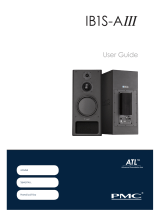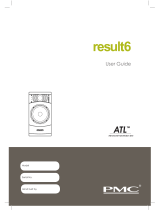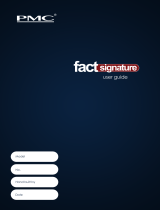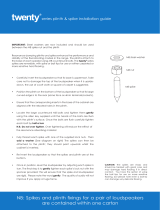Page is loading ...

User Guide
AML2
TM
Advanced Transmission Line


Please take a few moments to complete the warranty card at the
back of this booklet (or register at www.pmc-speakers.com) as this not only records
the purchase of your loudspeakers, but also provides you with an opportunity to
make suggestions and provide feedback directly to PMC.
For product support, accessories or servicing advice, please contact
a PMC authorised dealer. See www.pmc-speakers.com
© 2010 PMC. All rights reserved.
This document should not be construed as a commitment on the part of PMC. The information it contains is
subject to change without notice. PMC assumes no responsibility for any errors within this document.
CE Conformity: PMC active loudspeakers conform to CE Directive LVD 73/23/EEC and EMC 89/336/EEC.
WEEE European directive: PMC Limited is a member of a National Compliance scheme and has gained the
associated certication of compliance from the Environment Agency with the registration WEEE/GJ0101WU.
This symbol on the product and in or on its packaging indicates that this product must not be disposed
of with other household waste. It is the responsibility of the owner to dispose of waste equipment via a
designated collection point for the recycling of waste electrical and electronic equipment. The recycling
of waste equipment is an attempt to conserve natural resources and ensures that it is recycled in a manner
that protects human health and the environment. For more information about where to dispose of waste
equipment for recycling, please contact your local waste/recycling authority or the dealer from whom you
purchased the product.
PMC LIMITED
43-45 CRAWLEY GREEN ROAD LUTON LU2 OAA UK
T 0870 4441044 F 0870 4441045
email [email protected] web www.pmc-speakers.com
PMC USA LLC
17952 SKY PARK CIRCLE DRIVE SUITE A BUILDING 45 IRIVINE CALIF 92614 USA
T 949 861 3350 F 949 861 3352
email [email protected] web www.pmc-speakers.com
IMPORTANT
!

A message from Peter Thomas –
arguably the world’s smartest loudspeaker designer
and a truly obsessive audiophile.
Our sole aim while designing loudspeakers was to recreate the true essence of an artist’s
intention, combining the ultimate level of sonic resolution with solid engineering principles.
We believe that the same loudspeaker can be used throughout the entire audio chain,
from composer to studio or lm stage, post-production or mastering and then, nally,
the consumer. Our unswerving passion for getting it right has made this goal possible.
Thank you for choosing PMC products. It is now time for you to read the user guide,
install your new AML2s, and realise just how much you’ve been missing.
Peter Thomas
Owner & Chief Designer
“

Over two decades PMC has earned an
unrivalled reputation for creating the
world’s nest professional loudspeakers.
Simply put, our loudspeakers provide a
reference for the world’s highest prole
productions and events. They are found
at every stage of the creative process,
from conception to recording and
broadcast and, of course, in the home.
Our client list reads like a who’s who of the
sonically aware, with Prince,
Stevie Wonder, Robbie Williams, Coldplay,
Brian May, Universal, Sony, Dreamworks,
Deutsche Grammophon and the BBC
among the makers of movies and music.
Our loudspeakers were used in the
production of Titanic, Spiderman III,
Monsters vs. Aliens, Finding Nemo,
Pirates of the Caribbean III and during
broadcasts of the Beijing Olympics, 2008.
Tori Amos
Stevie Wonder
Francis Rossi (Status Quo)
BBC
Tony Bennett
Prince
Coldplay
UNIVERSAL MUSIC GROUP
Basement Jaxx
Robbie Williams
Royal College of Music
Brian May
Warner Music
Kraftwerk
Underworld
Emil Berliner/Deutsche Grammophon
Google
Siemens
Sony
Congratulations - You have joined the elite.

User Guide
AML2
Contents
General Usage Guidelines
Introduction
Unpacking and Care
PMC’s
TM
Advanced Transmission Line
– How the Advanced Transmission Line Works
System Description
EQ Options
Connections
Running In
Applications and Accessories
Positioning
Surround System Set-up
Operational Controls
The PMC Range
Service
Specications
Our Meticulous Care and Attention
Warranty on-line
Warranty certicate – Part 1 – Your copy
Warranty certicate – Part 2 – PMC’s copy
Help us improve – Your Comments
Inspection certicate

Read these instructions and keep them in a safe place for future reference.
Heed all electrical safety warnings, including any on the loudspeakers themselves.
Do not use the loudspeakers near water.
Do not install the loudspeakers near any heat sources such as radiators, ovens or other
very hot equipment.
Do not attempt to service the equipment. There are no user serviceable parts inside.
Please refer all servicing to PMC authorised personnel.
Servicing is required when the apparatus is damaged, exposed to moisture, or exhibits
a distinct or sudden change of operation or audio performance.
Unplug this product from both signal source and power during electrical storms or
when unused for extended periods of time
Packaging material can pose danger to the young and vulnerable. Ensure these items
are stored or disposed of safely.
The AML2 monitor loudspeaker can produce sound pressure levels in excess of 110dB.
Long-term exposure to high levels of sound has the potential to cause hearing
damage. Use care when adjusting the system volume to ensure sound pressure levels
remain within safe and comfortable limits.
The AML2 loudspeaker contains very powerful magnets and therefore may have
detrimental effect on magnetically sensitive items nearby, such as CRT (tube-style
televisions or monitors, and media such as oppy discs, cassettes and videotapes.
The cabinet should only be cleaned with a dry, lint-free, cloth. Do not use solvents,
abrasives, waxes or liquids as they may be detrimental to the nish.
To avoid damage to ooring when using PMC Tube 104 Stand™, the user should
determine the suitability of either spikes or protective glides.
PMC has made efforts to provide accurate installation information and good quality
xings. However, PMC LTD/PMC USA LLC will not be held responsible or liable for injuries
or property damage (direct, indirect or consequential) arising out of use or inability to
use this product safely and properly.
General Usage Guidelines

Introduction
The AML2 monitor supersedes the legendary AML1 and takes the AML monitoring concept to
new levels of audio transparency through an array of signicant technical improvements. Like
the original, the AML2 has been rigorously designed to provide the ultimate in loudspeaker
engineering excellence, free of any constraints in application. This loudspeaker system is just as
suitable for a state-of-the-art recording or mastering studio as it is for an audiophile’s listening
room.
The AML2 retains its predecessor’s revolutionary at piston bass-driver constructed from the
space-age materials of NomexTM and carbon-bre, along with the timeless qualities of silk in the
bespoke soft-dome HF unit. However, the new OAM1 Op-Amp Modules employed in the EQ
circuitry have reduced both distortion and noise, bringing noticeable improvements to the sound
staging and separation in the mid and high-frequency regions. The rear of the cabinet structure
has also been made stronger, and the electronics supported more rigidly – both contributing
to even lower levels of cabinet colouration and making the AML2 even more robust. Magnetic
shielding is, of course, included as standard.
Bass is loaded by PMC’s unique implementation of TM
Advanced Transmission Line
(Advanced Transmission Line)
technology. This design approach uses contemporary materials to provide optimised absorption
of unwanted midrange energy within the cabinet, whilst extending bass output signicantly.
The smooth response of the very high-power tweeter extends beyond 22kHz and uses a
perforated grille that acts as an acoustic lens to control dispersion, working in concert with a
waveguide contour integrated into the front bafe. This arrangement guarantees supreme sound
staging and imaging accuracy.
The electronics built into each cabinet comprise two channels of power amplication designed
by Bryston – the world’s leading audiophile amplier manufacturer. The active crossover section
employs steep 18 and 24dB/octave lters, a transparent protection circuit, and user-adjustable
acoustic correction controls which can be totally bypassed when not required.
‘The AML2 is designed and hand built in England, by nice people who care, and who love audio’

Unpacking and Care
The AML2 monitor system is packed in a heavy-duty protective carton. Please retain this to ensure that
these monitor speakers can be transported safely if the need arises in the future. If you dispose of the
packaging please do so in an environmentally responsible and safe way.
Inside the packaging you will nd two region-appropriate IEC mains-power leads, a spirit level, and this
manual which incorporates a warranty registration card and test certicate. Please advise your dealer
if any of these parts are missing.
In normal usage PMC speakers should provide you with many years of trouble free operation, but in
the unlikely event that you suspect damage or failure has occurred please do not attempt to repair
the unit yourself. There are no user-serviceable parts inside. Contact your dealer for advice and a
service return address.
Cleaning may be carried out with a dry lint-free cloth. Avoid the use of solvents as they may damage
the nish of the unit.
!

harmonic distortion and the result is PMC’s
characteristically transparent midrange, fast,
attacking bass, and outstanding clarity.
A further advantage is greater bass extension
and loudness than a ported or sealed
design of a similar size, even if similar drivers
were used. Moreover, the very consistent
bass driver loading brings the welcome
benet that the frequency response remains
consistent regardless of listening level, and
analytical auditioning can be conducted
without the need for high replay volumes to
achieve optimal bass response – a unique
and very valuable characteristic.
PMC’s unique TM
Advanced Transmission Line
(Advanced
Transmission Line) enclosures have taken
loudspeaker design to the highest level,
using sophisticated cabinet construction,
proprietary drive units, and patented
absorption materials and techniques. The
benets are enormous compared to the
relatively simple sealed and ported designs
currently available elsewhere.
PMC’s innovative approach places the bass
driver near one end of a long tunnel (the
Advanced Transmission Line). This tunnel
is heavily damped with acoustic material
specied carefully to absorb the upper bass
and higher frequencies radiating from the
rear of the bass driver. The lowest frequencies
are allowed to pass down the line and
emerge from the large vent in the same
polarity as the driver’s frontal radiation,
the vent acting essentially as a second bass
driver.
An important benet of the TM
Advanced Transmission Line
approach
is that the air pressure inside the cabinet,
loading the bass driver, is maintained.
This helps to control the driver over a wide
frequency range and signicantly reduces
LF distortion. Consequently, the upper bass
and midrange detail is not masked by
How the Advanced Transmission Line Works
TM
Advanced Transmission Line
‘No other bass loading technology provides such resolution and tonal accuracy at all volume levels’
AML2 cross section
showing TM
Advanced Transmission Line

System Description
All of the amplier stages designated by the
white triangles in the diagram above are
ultra-low distortion, high-performance OAM1
Operational Amplier Modules. All of the
associated passive components, including
OSCON™ capacitors, are audiophile-grade
units, with tightly controlled tolerances.
The LF driver protection circuitry does not
affect the signal in any way until the very
onset of clipping. The original AML1 also
included an HF driver protection circuit,
but this has been removed in the AML2
with a small, but worthwhile, gain in HF
transparency.
The electronic crossover sections provide
a 24dB per octave slope for the LF channel
and an 18dB per octave slope for the HF
channel; the combination delivering a
smooth transition between drive units across
the critical mid-band.
The power amplier sections shown by the solid
black triangles above are both discrete Class
A-B designs with a very wide audio bandwidth.
The LF amplier can deliver a conservatively
rated 100Wrms of power, while the HF amplier
can deliver 80Wrms.
When the room equaliser (EQ) switch is pressed
its associated LED changes colour from green
to red and the user can then modify the tonal
balance as necessary, with HF Tilt, LF Tilt and
LF Roll-Off controls. Deselecting the Room
Equaliser bypasses all of the associated circuitry
completely.
The graphs overleaf illustrate the effect of these
controls upon the response of the system.
‘No other bass loading technology provides such resolution and tonal accuracy at all volume levels’

EQ Options
W
X
A
D
B
C
E
F
G
Z
Y
The frequency response plots above illustrate the cross-over lter responses as well
as all the response variations that can be obtained using the various EQ controls.
A LF Tilt: +3dB
B LF Tilt: +1.5dB
C EQ Bypassed
D LF Tilt: -3dB
E LF Roll-Off: 50Hz
F LF Roll-Off: 80Hz
G LF Roll-Off: 90Hz
W HF Tilt: +2.5dB
X HF Tilt: EQ Bypass
Y HF Tilt: -2.5dB
Z HF Tilt: -5dB

Connections
!
!
Caution
To avoid potential damage, please ensure that the signal source is turned off before
connecting or disconnecting your active loudspeakers.
The rear panel of the AML2 carries two connectors: audio and mains power.
Audio
The electronically-balanced audio input accepts a 3-pin male XLR, wired as follows:
Pin-1 Screen (ground)
Pin-2 Signal Positive (hot)
Pin-3 Signal Negative (cold)
If the monitor is to be used with an unbalanced signal source, pins 1 and 3 of the input
XLR should be connected together inside the male XLR plug.
A single IEC (C14) mains socket is provided with an integral fuse-holder and power switch.
The appropriate mains operating voltage is indicated on the rear panel and is set at the
factory, but it can be changed by an approved dealer if necessary. The fuse is rated for
the appropriate input current and replacement fuses should always be of the type and
rating specied on the rear panel of the loudspeaker. Only change fuses with the power
cord removed completely from the loudspeaker.

Running-In
12
11
10
9
8
765
4
3
2
1
When brand new, PMC loudspeakers will take a short period of use before they
reach their full potential.
This is because the mechanical and acoustical characteristics of both the bass
and treble drive units alter slightly after manufacture as the exible elements in
their construction relax and reach their optimum compliancy. The TM
Advanced Transmission Line
cabinet
parameters are critically designed to load the bass driver accurately only when
it has reached its long-term, optimal compliancy.
Consequently, during the initial running-in period of about 20 hours, the
performance of the AML2 active monitor will change and improve. You will
notice the bass tonality becoming warmer, fuller and more natural, and the
bass extension will increase signicantly. As the tweeter relaxes the treble
tonality also sweetens and the sound staging improves.

Applications and Accessories
The compact yet large-scale performance of the AML2 allows its use in any application where
a clean and neutral but powerful presentation is required. Typically, AML2 monitor loudspeakers
are used for high-power neareld monitoring in music and speech recording and mixing, outside
broadcast vehicles, radio on-air studios and television sound control galleries, home theatre
and high-end domestic hi-, project music studios, post-production and editing suites, quality
monitoring, music mastering, and A&R evaluations.
It is critical that monitor loudspeakers are positioned at the correct height and kept
stable during operation. However, the structure and materials used to support the
monitor will have a bearing on how it performs. The purpose-designed PMC Tube
Stand™ was developed with extensive listening tests in both the consumer and
professional environments to optimise the imaging, dynamics and overall tonal balance
of all of PMC’s compact monitors. The Tube 104 Stand™ (1040mm tall) is ideal for
professional applications. Four M8 threaded inserts at the base of the AML2 allow the
monitor to be secured safely to the stand, or to any other compatible mounting such as
the Powerdrive 100 Series of wall or ceiling mounting brackets (see: mypowerdrive.com).
For applications requiring greater low frequency extension, either the SB100 passive subwoofer
or the SB100-A powered subwoofer are recommended. Harmonic
distortion generated by a poor quality subwoofer will mask critical
mid-frequency information from the main monitors, and also reveal
the physical location of the subwoofer. However, PMC’s unique TM
Advanced Transmission Line
cabinet design and at, 10-inch carbon-bre & NomexTM bass driver
ensures extremely low levels of harmonic distortion and provides
seamless integration with the AML2.
The AML2 can also be used in mix’n’match setups with other PMC monitors for surround sound
applications. All PMC monitors share the same characteristics of wide dispersion, low distortion,
consistent voicing, and an even bass response regardless of listening level.

Positioning
With their unique TM
Advanced Transmission Line
cabinet design, wide dispersion, ultra-low distortion, and smooth bass
roll-off, PMC loudspeakers are more forgiving of difcult room conditions and placement
constraints than conventional designs – you will be able to achieve a superb sound throughout
the room with little effort. However, we encourage you to spend some time experimenting in
your own room to achieve the very best results, remembering that small changes in location
can often inuence system performance signicantly. The following guidelines are suggestions
for a starting point to locate your new loudspeakers. Fine-tuning of their positioning can start
from there.
Most loudspeakers have a relatively narrow dispersion and are designed to be aimed directly
at the listening position, as shown in the left-hand image below. However, the excellent stereo
imaging which PMC monitors are known for is due, in part, to their wide dispersion characteristic,
as shown on the right-hand image. To optimise the stereo imaging, PMC monitors should be
angled so that their axes cross about 0.5 metres (2ft) behind the listening position (as illustrated
below). Varying this toe-in angle will subtly affect the vividness of the audio soundstage.
A good music track with vivid vocals will help to determine the best position.
Conventional Monitor
Narrow Dispersion
PMC Monitor
Wide Dispersion

TIP
TIP
TIP
When initially positioning the loudspeakers, ideally they should be located at two of the three
points of an equilateral triangle, with the listener at the third. If the monitors are spaced too far
apart the stereo image will be wide but central denition will be impaired. Use a well recorded
vocal track to judge the ideal placement.
Attention should be paid to the effect of reective surfaces such as side walls and objects in
close proximity to the loudspeakers, as excessive neareld reections will blur the stereo imaging
signicantly and may introduce unwelcome colouration of the sound.
Place the speakers so that their front bafes are well forward of any objects placed between
them, such as computer display screens.
With regard to vertical placement, the acoustic axis of the AML2 is midway between the two
drivers. This axis should be level with the listener’s ears, as illustrated in the diagram below.
To prevent vertical room modes from causing boominess, do not position the speaker such that
the bass driver is at an even proportion of the room height, such as a half or a quarter.
If the speakers are mounted above or below ear level then angle the speaker towards the
listening position

One source of sound
at the crossover point
Two sources of sound
at the crossover point
Positioning (Cont.)
The AML2 is designed to be used upright to ensure optimum stereo imaging, tonality and
amplier cooling.
Around the crossover frequency both drive units are inherently reproducing the same audio
signal (although PMC designs employ steep crossover lters which minimises this), and so there
are inevitably two sources of sound. When the drive units are aligned one above the other the
two wavefronts emanate from one vertical plane and both will arrive at the listener at the same
time, providing accurate stereo imaging and minimal colouration. This is illustrated in the left
diagram below.
In contrast, if the speaker is mounted horizontally the wavefronts from the two drivers radiate
from two horizontally spaced points. This results in different arrival times at the listening position for
sound from each driver, producing colouration and vague stereo imaging (right diagram) below.
:
:

TIP Ideally, the monitors should be placed more than 0.5 metres from the side and rear walls of
the room so that reinforcement and cancellation (peaks and dips) of the bass output caused
by wall reections will be moved higher in frequency and thus less inuential. This reduces the
incidence of ‘lumpy’ or ‘boomy’ bass. Small changes in position can have profound effects on
the bass response, so experiment to nd the optimal position.
AML2 monitor loudspeakers can produce signicant bass energy below the frequencies at which
they become omnidirectional. As a consequence, it is important to consider the effect of the
boundaries of the listening room when placing the monitors.

The AML2 monitor has been designed for perfect multi-
channel music or movie playback, and the following
diagrams indicate the ideal layout for the speakers.
The constraints of room size and shape will often
force some loudspeakers to be placed closer or
further from the listening position than is ideal.
In such situations the time-alignment facilities of the
surround processor or monitor controller should be
employed to compensate.
The subwoofer carries the LFE signal as well as
the low bass from some, or all, of the main monitors
when bass management is being used. The subwoofer should be placed at the front of the
room, the optimal position providing the smoothest low bass without boomy or weak notes.
In a system capable of 7.1 Dolby® Digital Surround EX™
DTS® ES™ or Blu-ray™ playback, there will be two sets of
surround speakers. The rst pair (surround or side channels)
should be positioned at 100º, and the second set (rear or
back channels) at 150º. (The front centre axis is 0º while
directly to the rear of the room is 180º).
Dolby® Digital Surround EX™ is a registered trademark
of Dolby® Laboratories. DTS® ES™ are registered
trademarks of DTS® Inc. Blu-ray™ is a trademark of
the Blu-ray™ Disc Association.
Fine tuning for perfect sound
Surround Sound Systems
TIP
TIP
/











